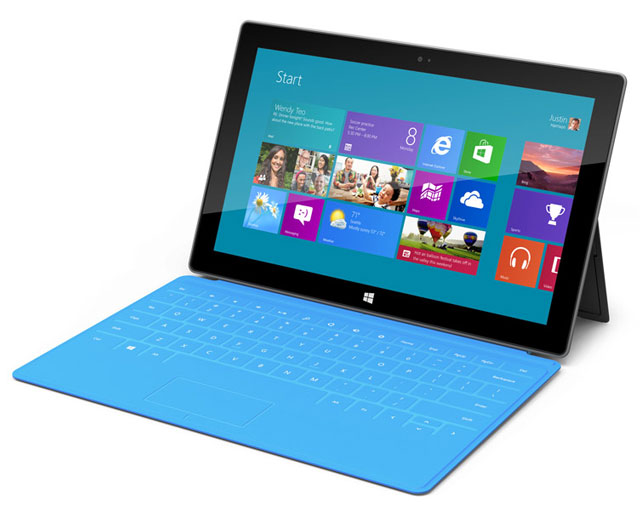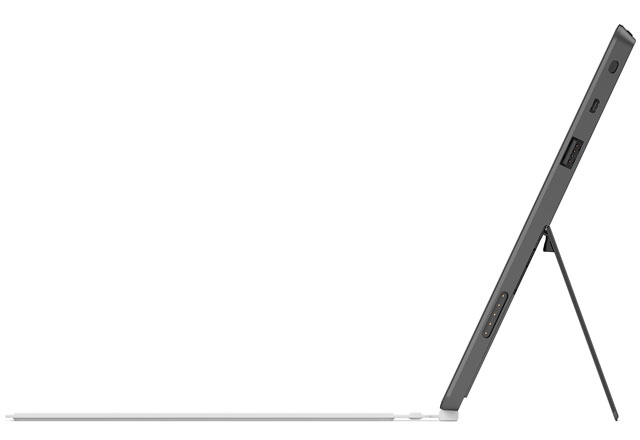
The Surface is Microsoft’s long-awaited tablet. It’s sold as a “do-everything device”, a laptop when you need to get real work done and a tablet when you want to use it more casually. It’s supposed to mark a new era for Microsoft: making and designing its own products. But is it any good?
First off, the Surface is well designed. The body is clad in some sort of magnesium alloy that Microsoft calls “Vapor Mg”. It reminds me somewhat of the anodised aluminium on the black iPad mini. The industrial, clean, understated design blends in well with Microsoft’s new look.
The rear kickstand is also a big part of the design, and Microsoft is touting it as a key feature. But at the size this is, I think it’s more out of necessity. It’s sturdy and works well, although you can’t adjust the position and it’s not very useful on your lap.
A capacitive Windows home button sits on the all-glass front. Along the top of the device, you’ll find a sleep/wake button on the upper-right edge. On the left side is a volume rocker and a headphone jack, while on the right side are USB 2, micro HDMI and magnetic charging ports. A micro SD slot, supporting cards of up to 64GB, is hidden underneath the kickstand.
There’s a distinctly average set of stereo speakers that sit on each side. Also included is a front- and rear-facing set of 720p cameras. The front-facing camera is handy for Skype video calls, but I don’t see any point to the rear camera.
The Surface is quite big for a tablet, with a dimension of 22,75cm x 17,2cm x 9,2mm it comes in somewhere between a full-sized iPad and an 11-inch MacBook Air. It’s uncomfortable when using it as a tablet; partly due to the fact that it weighs 680g and partly to the display’s 16:9 aspect ratio. It’s well suited to Windows RT and for watching movies, but terrible for reading and using it without the kickstand.
The display itself is 10,6 inches and has a pixel resolution of 1366×768 for a pixel density of 148ppi. It’s not going to win any awards and is certainly no challenge to an Apple Retina display, but it gets the job done.
Powering the Surface is a quad-core Tegra 3 chip clocked at 1,3GHz, paired with 2GB of RAM. On paper it sounds like it’ll suffice, but real life performance is hit or miss. In daily tasks, the performance is fine — navigating through the operating system, browsing the Web, checking Twitter and e-mail, playing the odd game is generally fast and smooth. But once you start multitasking, get the RAM full or type up something in Word, you quickly lose patience with lag and underwhelming performance.

I found battery life on the Surface great, getting through a full day of pretty heavy use without much hassle. Expect about nine hours of medium use.
The Surface RT’s biggest letdown is its operating system, Windows RT, a stripped-down version of Windows 8 that lacks the ability to run “legacy” software. Much like the iPad, all you can do is download and use software available in Microsoft’s App Store, which right now is a desolate wasteland.
I’m pretty sure the apps will be there at some point in the future, but right now it’s severely lacking and that’s a big mark against the Surface.
Don’t get me wrong: I love the idea of Windows RT. It’s fresh, innovative and one of the best touch-based operating systems I have used. Multitasking is brilliant and the tile interface is really inventive. Windows RT has a lot of potential, but Microsoft is going to need to work hard in order to fix all the current problems and bugs.
The Web browsing experience is good in the new (Flash-equipped) Internet Explorer 10, and the Surface comes with a free copy of Office 2013 that includes Word, Excel and PowerPoint. To take full advantage of Office, Microsoft gives you the option of buying a type or touch cover, which is an essential if you buy the device. The cover is essentially a keyboard that attaches magnetically to the bottom of the Surface.
The type cover uses physical keys and is surprisingly good. Your reviewer typed up his notes for this review on it and can report that the keys are responsive, easy to hit and offer great feedback. The touch cover is quite a sensation as it trades physical keys for a cardboard-like fabric with an embossed, raised surface where the keys are supposed to be. It takes a while to get used to but, once you do, it’s not a particularly great experience.
Keys need a lot of pressure to work and, when they do, they aren’t terribly accurate. Each cover also includes a mediocre multi-touch track pad, but you won’t be using that often.
While using the Surface, I kept wondering: who is this device for? It’s trying too hard to be a laptop, which doesn’t make it any good at being a tablet. It does the job of a tablet and the job of a laptop half as well as other devices on the market, and it by no means makes that job easier.
It’s better suited for those needing a small, powerful machine — those who are willing to tolerate its minor troubles than for those wanting to read their e-books or play a bit of Angry Birds. It’s an amazing device, but the current flaws don’t make it a worthwhile purchase.
- The Surface RT is not available through official channels in South Africa but can be sourced internationally
- Review unit supplied by Mustek




